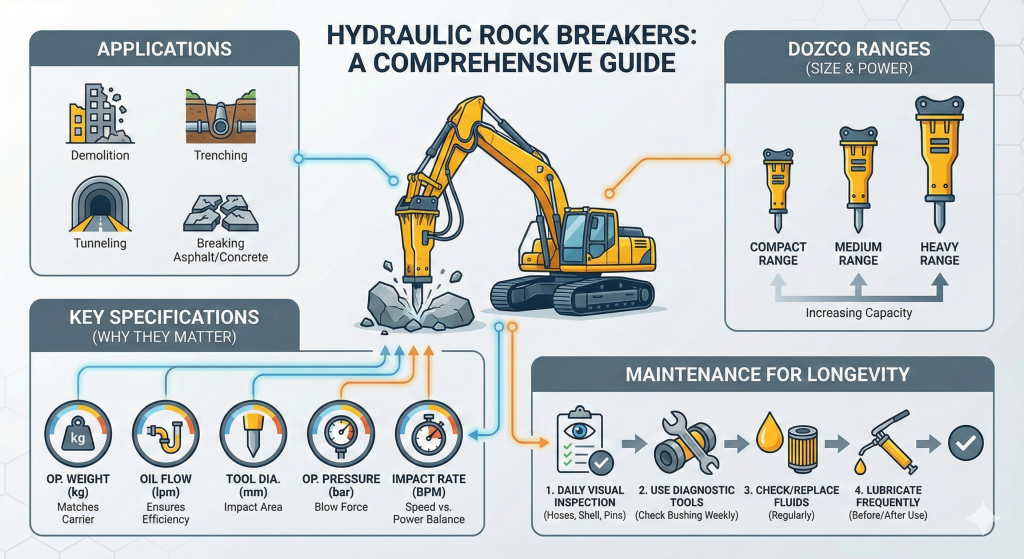In the construction, mining, and demolition industries, a powerful machine is needed to break down hard surfaces. A hydraulic hammer or a hydraulic rock breaker is required for such industries to make the process much more efficient. However, these tools come in different sizes and features depending on the machine (e.g. excavators, backhoes, skid and steer loaders) and for which purpose you need them.
This article offers a comprehensive view of hydraulic rock breakers, the various types available, their operating weight, impact rate, etc., and how you can increase their longevity. Let’s get started by understanding the attachment:
What are Hydraulic Rock Breakers?
Hydraulic hammers or rock breakers are attachments used in excavators, backhoes, and skid steer loaders for
- Demolition
- Primary and Secondary breaking
- Trenching
- Breaking asphalt and concrete
- Tunneling job, etc.
Types of hydraulic breakers available at DOZCO
As we have already mentioned, there are several types of hydraulic rock breakers available in the market, with different features and applications. At DOZCO, we have segmented our rock breakers into three categories:
- Compact Range
- Medium Range
- Heavy Range
Why do these key specifications matter?
- Operating Weight (kg) determines which carrier machines (excavators, backhoes, skid‑steers) can safely lift and handle the breaker. Too heavy a breaker can overload your carrier’s boom and hydraulics, while too light a breaker may not deliver enough power for tougher jobs.
- Oil Flow (lpm) is a critical factor for hydraulic breakers. If the breaker requires more flow than your machine can supply, you’ll lose impact energy and productivity. If it needs much less, you might be under‑utilizing your machine’s power.
- Tool Diameter (mm) describes the size of the chisel and the contact area on the rock or concrete. A larger diameter tool delivers more impact energy per blow (better for breaking thick, hard materials), while a smaller tool is better for more precise work or cutting trenches.
- Operating Pressure (bar) shows the force behind each hammer blow. Higher‑pressure breakers hit harder, making them ideal for deep rock fracturing.
- Impact Rate (BPM – blows per minute) balances power with speed. A high‑BPM breaker delivers many lighter blows per minute. It is ideal for softer materials or faster work. Whereas a lower‑BPM delivers a heavier‑blow breaker and is better at smashing through very hard rock in fewer, more damaging strikes.

Hydraulic Breaker Maintenance Tips
It’s true that hydraulic hammers are specially designed to work in adverse conditions. But they do need regular repair and maintenance to perform optimally for a long period.
Here are a few tips that may come in handy to increase the lifespan of your rock breaker:
1. Conduct Daily Visual Inspections
Daily visual inspection is the key to avoiding sudden breakdowns and workplace accidents. Plus, it doesn’t take a long time. Look into these few things:
- Hydraulic hoses for cracks or leaks
- The breaker shell for dents or fatigue
- Pins, retainers, and locks for wear or looseness
- The tool point for cracks, chipping, or gouges
2. Use the right Diagnostic Tools
It is essential that you use the right diagnostic tool to check hydraulic breakers. It is recommended that you remove the breaker tool weekly or every 50 operating hours and check the bushing.
3. Check and Replace Hydraulic Fluids Regularly
Hydraulic fluids are the source of power for hydraulic systems. These fluids are also essential for lubrication and dissipating heat. Using contaminated or old hydraulic oil can damage both the breaker and the carrier’s hydraulic system. So, it is important to check and replace the fluids on a regular basis.
4. Lubricate the Breaker Tool Frequently
Lubrication helps to avoid wear and tear. However, you need to choose the right and genuine grease, otherwise, it may end up thinning out. As rock breakers are heavy-duty attachments, you should apply grease before and after using them, as well as every 2-3 hours if you are working in a dusty environment.
Final Thoughts
For heavy-duty tasks, you need powerful tools and attachments to cut down time and increase safety. A hydraulic rock breaker is one such attachment that can improve your operational efficiency multifold. But you do need to choose the right equipment and how to maintain it. If you’re planning to purchase, check out our collection at DOZCO, manufactured with advanced technology!
FAQs
-
Can I just use any rock breaker for my excavator?
No, you need to consider the excavator size and its application, or it may end up impacting your work pace.
-
How should I choose a rock breaker, then?
There are several factors to consider when you choose a rock breaker, for example:
- The environment where you will use it – types of rock to be broken, application type, available carrier etc.
- Maintenance and Service availability
- Safety Features
- Energy and Power efficiency
- Initial purchasing budget and long-term cost
-
Are rock breakers popular for mining tasks?
Yes, mining involves breaking large chunks of rock into smaller pieces, which a hydraulic hammer excels at. Rock Breakers are mainly used in mining where blasting is restricted.
